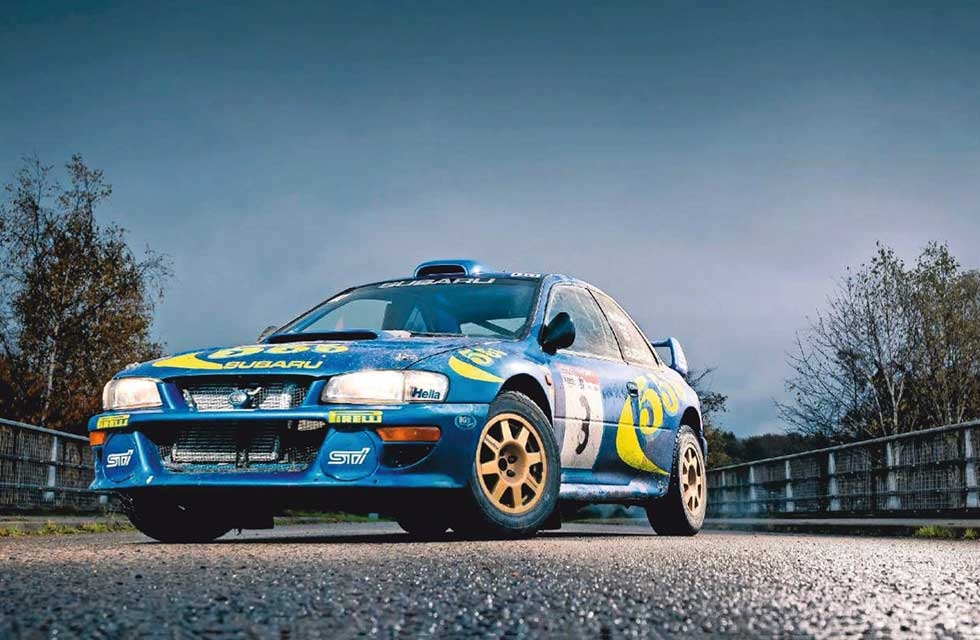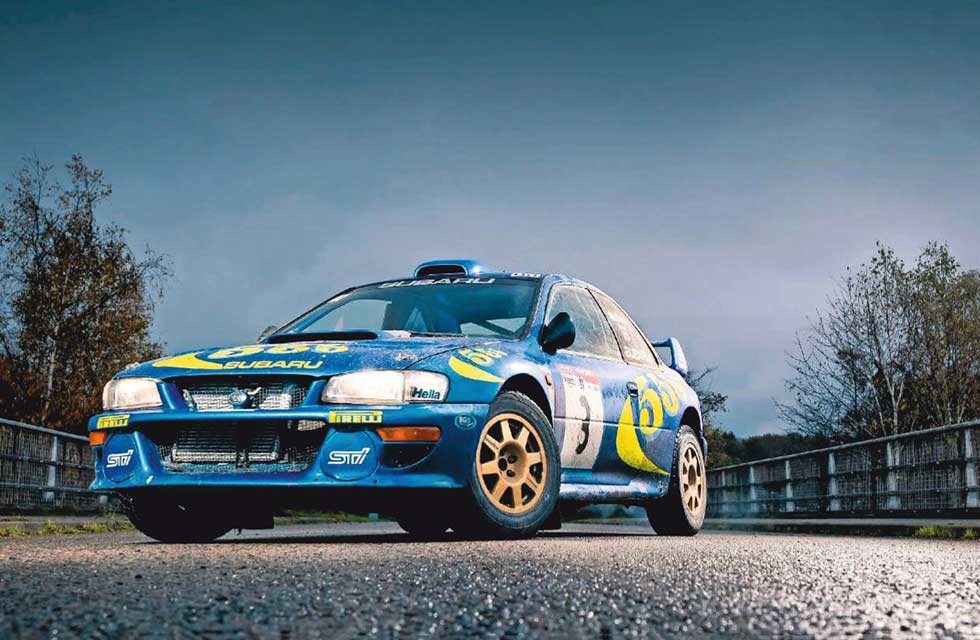
McRae’s Impreza driven a bit sideways – Mud & Thunder. This Impreza nearly delivered, then ultimately cost, Colin McRae his second World Rally Championship. We drive it at maximum attack and relive victory and defeat. Words Sam Dawson. Photography Jonathan Fleetwood.
‘Torque slams me back in Colin’s chair as turbocharger, exhaust and gearbox all howl together’
Flat-out in a rally icon – the Subaru Impreza that nearly won Colin McRae a world title
Mud & Thunder
Driving Colin McRae’s 1997 Subaru Impreza. Sideways. On gravel.
Colin McRae was Nigel Mansell on gravel. In the early Nineties both men ended painfully long droughts of British success with championship wins at the highest level of their respective motor sports in a uniquely British style. In an era of seemingly superhuman multi-title winners with effortlessly clinical driving styles and urbane, corporate interview manners, they made us feel every bone-crunching barrier impact, every radiator-perforating disappointment. Sainz and Kankkunen, Senna and Prost – they made it look easy. But through brawling for every point, bouncing back from every setback, and delivering it to us via an adoring media with characteristic dry wit and gallows humour loved by fans but tooth-gritting to PR people, this British pair left us in no doubt that becoming World Champion was, in fact, bloody difficult. And thus utterly heroic.
‘The pebble rash on the car’s flanks attests to a life of continuous, nailbiting drama’

I’m feeling somewhat overawed as I put my helmet on and negotiate the carbonfibre-clad roll cage of this Subaru Impreza WRC that Colin drove in three events of the 1997 World Rally Championship season. My first sight of a yellow-on-blue Subaru Impreza came on a chilly Welsh forest road in 1993. Colin was ahead in the Network Q RAC Rally, trading stage wins with Juha Kankkunen’s Toyota Celica GT-Four, tantalisingly close to defeating the Finn with this previously unknown Japanese weapon.
An unfortunately-placed rock in Wauchope forest two days later brought this run to an end, but that didn’t matter. My generation had a new set of icons – Colin McRae, the Subaru Impreza Turbo, and the pre-tobacco ban 555 livery of Prodrive.
As I wedge myself into a bucket seat that bears Colin’s name, shaped to hold him and him alone in place behind the wheel, I start to feel apprehensive. Is it the car itself or the win-or-crash reputation of its driver that’s intimidating me more, as I eye the muddy gravel ahead. Do I deserve to be here at all? I’ve driven this car before, in pixel form on a computer game called RAC Rally Championship. I never dreamed, as a 15-year-old hammering a keyboard prompting digital Colin into a powerslide through Grizedale Forest, that I’d ever be in this position for real.
‘McRae rotated his body anti-clockwise and relieved himself at 100mph’
This 1997 machine is from the first year of the World Rally Car rules, aimed at reducing costs for manufacturers and increasing participation by eliminating the need to include items like turbochargers or four-wheel drive systems in their homologation specials as required by the outgoing Group A legislation.
Turbocharger air restrictors were also mandated, aimed at preventing a Group B-style power war, but this car still feels very much like a silhouette device only made to look like the short-wheelbase Impreza P1 from which it derives its Sport Quattro-like truncated bodywork. Rally-thoroughbred heavy-duty tubing and cooling mechanisms glare beneath vent holes that don’t even bother with protective mesh. Its muscles are ripping through its clothes. Its arches bulge wide to cover its gravel tyres. Not even Colin was satisfied with its widened track, requesting Prodrive’s engineers narrow it after half a season wrestling with the Impreza WRC. They duly did, and when it was pointed out in a press session ahead of Rally New Zealand that the arches were still very wide regardless of where the wheels sat in them, McRae quipped ‘It’s only bits of pressed tin. You can reduce them in size quite quickly!’
As I switch both fuel pumps on and hit the ignition button, I’m expecting an unruly beast with a knife-edge clutch and a switch-like throttle, near-impossible to meter through pedals sprung like bear traps. A deep, aggressive, serrated throb erupts around me, the bare metal and carbon-fibre cabin echoing the din all over the place. This deafening noise is part induction roar, part flat-four pulsation, part exhaust chatter, and it’s coming at me from every direction. I prod the throttle to get a sense of the pedal’s travel and progression, and there’s a new sound to add to the cacophony as the massive steel-turbine, 69mm-compressor, anti-lagged IHI RHB turbocharger, whistles in far lower down the rev-range and much more urgently than any road car would dare. What rpm does it kick in at, exactly?
I’ve no idea. The rev counter and speedometer are stark electronic bar graphs designed solely to tell me when to change up a gear, its glow changing from cold blue to angry red when it’s time. Precision measurement is outsourced to marshals with timesheets.
I get it into gear with a firm shove – even so, the very short-travel lever doesn’t quite feel like it’s slotted home even though it is – and the noise gets louder still as screaming straight-cut gears join the chorus. I ease off the clutch and hope I don’t stall.
I haven’t. Instead, the Impreza proves extremely easy to rocket through the gears so long as you’re assertive. Torque slams me back in Colin’s chair as turbocharger, gearbox and exhaust all howl together, each upshift accompanied with a slight shimmy from the rear wheels, revs leaping violently between gearshifts. Pebbles are ricocheting off the underside and the middle of the track is marked with a muddy bank. I’d think twice about flooring a hot hatch down terrain like this, let alone a full-blown competition car.
I’m rapidly approaching an urgent 90-degree left-hander, and I stab the brakes in anticipation. There’s no ABS, and I worry about the big discs locking up and turning the Impreza into an out-of-control bowling-ball. But instead of understeering unstoppably into certain bankruptcy, I suddenly realise that the car wants to work with me. Powering through the bend, all four wheels grip hard on the slippery ground. The steering is disarmingly urgent, almost all the movement required for anything short of a 180-degree hairpin available within a quarter-to-three grip with no need to shift my hands from their positions. Just point the nose, apply the power, and the car changes direction with the precision and immediacy of a single-seater racer. All on boggy, storm-pulverised gravel.
Armed with the realisation that the car wants to help me get the best from it, I feel I can start taking a few liberties. Barrel hard into a corner, mash the throttle pedal before the exit line is quite straight enough, and the car twitches sideways, sending gravel flying.
And yet the combination of steering speed and sharpness, the compliance of the hydro-electronically controlled active differentials – which lock automatically when slip is detected unless overriden by the driver – and the sheer grip of the gravel tyres mean any slide is easily controlled, either arrested or manipulated to my advantage. As I hurtle towards a water-splash of indeterminate depth, I find myself eyeing the windscreen wipers. They look remarkably standard, like the sort of thing you’d buy at Halfords, not some heavy-duty, painstakingly developed items pushed down by aerodynamic blades. And yet they still manage to sweep the bow-waves of filthy water neatly off the screen.
Brakes that worried me initially with their lack of an antilock system in a car so powerful soon reveal themselves to be reliant and faithful. But as with everything else with this car, you need to be firm and decisive with them and they’ll work with you to provide what you want. Including a World Rally Championship.
For a while, things looked that way for Colin McRae back in 1997. Always thrilling to watch in a heart-in-mouth, will-he-do-it manner, Colin had clinched the 1995 WRC title in front of home fans – myself included – at the season-ending RAC Rally despite severe suspension damage to his Impreza, leading teammate Carlos Sainz to a Subaru one-two finish. A torrid 1996 followed, marred by crashes, a motorcycle accident, the departure of long-term navigator Derek Ringer, a $75,000 fine from the World Motor Sport Council for speeding through a service area in Argentina, and the dominant arrival of the Schumacher-like Tommi Mäkinen in the Impreza’s mechanical nemesis, the Mitsubishi Lancer Evolution III.
In 1997, McRae was on course to seize his second WRC title, and also silence the less partisan critics of the international motor sport scene who’d chided him ever since his car-wrecking antics in the late Eighties with Ford. He had to prove the disastrous 1996 season was a blip, not a return to the bad old days, no matter how entertaining he might have been to watch at times.
‘Point the nose, apply the power, and it changes direction like a single-seater’
Alongside ex-Kankkunen navigator Nicky Grist, McRae first climbed aboard this Impreza WRC on 1 March 1997 to take on the rally most likely to test the abilities of any rally driver to their limits – the Safari Rally Kenya. Grist worked with McRae to develop a new style of pacenotes for the rally, McRae previously preferring minimal description, describing complexes of bends rather than a feature-by-feature commentary. The pair came up with a one-to-six grading system for corners, a four-level description for terrain roughness, and single words to warn of potential car-wrecking obstacles like rocks and ditches.
Also new to McRae’s Prodrive entourage was a fitness coach who insisted on the team hydrating themselves much more in the Kenyan heat. In the midst of the rally’s first stage, having pre-emptively drunk a huge amount of water, McRae was desperate for the toilet. Unable to stop the car, he changed into sixth gear, undid his belts, jammed his right foot on the accelerator pedal, told Grist to take the wheel, rotated his body anticlockwise and proceeded to relieve himself in the direction of the driver’s door as the car sped through the desert at 100mph. Grist had to guide the car through two tricky corners with McRae in this state. At the end of the stage, it transpired that Mäkinen had retired with transmission failure, and McRae and Grist had actually set the fastest time by a clear three minutes. It was a lead they maintained throughout the brutal event.
The next time McRae used this car, for the Rally Argentina, he was fresh from a win on the punishing tarmac of the Tour de Corse, which had seen Mäkinen retire again. The playing field seemed even, McRae starting just two points behind Mäkinen, winning ten stages, and finishing second behind his rival.
Then the mechanical failures began. Steering failure dropped McRae out of the Acropolis, a cambelt snapped in New Zealand and an engine problem took him out of contention on the 1000 Lakes. If he scored podium finishes on every remaining rally of the season, he could still theoretically beat Mäkinen. At home, gazes fixed on our televisions for Rally Report, we dared to dream. This car, with a win and a second place to its name, seemed like a lucky bet that would give McRae and Grist a fighting chance on the pivotal Rally Indonesia. McRae soared into the lead, maintaining a running first place with decisive performances on the first ten of the rally’s 22 stages. On stage 13 at Gunung Para, Mäkinen retired with a holed radiator.
McRae’s path to regaining his championship was clear. Yet less than an hour later, on a Goodyear-sponsored special stage, McRae clipped a rock that damaged his radiator too. With the car still running, he persevered to the next rain-lashed jungle-clearing service halt, but it was too late. Flames roared through the crumpled bonnet’s vent; the title charge was dead.
‘It feels like a silhouette device only made to look like the Impreza P1’
In sister Prodrive Impreza WRCs, McRae sealed the 1997 manufacturers’ championship comprehensively for Subaru, scoring straight and faultless wins in Australia, Sanremo and on the RAC. Mäkinen took his second driver’s title with 63 points. McRae’s total stood at 62.
McRae might have missed out on the glory of a second WRC title – a remarkably similar series of events was to follow with Ford in 2001 as well – but by this point he’d made the transition from cult hero to national treasure. The big-selling computer game that Christmas was Colin McRae Rally, its front cover featuring this Impreza flying to victory on the Safari.
In 1998, he confirmed his multi-disciplinary driver credentials once and for all by winning the Race of Champions. Not long after, he appeared in an infamous round of ‘Feel the Sportsman’ on the BBC’s high-profile comedy sports quiz They Think It’s All Over, which saw a blindfolded Rory McGrath and Gary Linekar showered in mud as McRae and Grist arrived on stage to rapturous applause. Not even Roger Clark received this level of broad public recognition.
And the car? In October 1997, before McRae had even finished his title charge, the fire-damaged Impreza was returned to Prodrive for repair before being sold to works-backed Italian Subaru team Amont, where it entered various tarmac rallies in the hands of assorted privateers including Markku Alen, who brought it home fourth on the 2001 Costa Smeralda.
However, its final moment of front-line glory came on the 1999 Rally di Monza. Former Ferrari F1 driver Ivan Capelli, navigated by Dino Zanatta, took the wheel of this Impreza and ran Renato Travaglia and Flavio Zanella’s Peugeot 306 Maxi to second place by just one second. The pebble rash on this car’s flanks attests to a life of continuous, nailbiting drama. Long may that continue.
Cockpit is full of lightweight carbonfibre, and still tailored to McRae’s preferences. This car’s first win came on the Safari, its demise on Rally Indonesia. Activate fuel pumps, toggle ignition, press ‘Start’… 1997 saw McRae first paired with WRC winning navigator. Nicky Grist With no ratchet, this is for handbrake turns only. The first time Sam drove this car was on a computer screen. This rally icon is surprisingly easy to control mid-slide, even for novices. The tiny numbers on the LCD display provide minimal quantitative info at a fleeting glance. Modifications permitted by new WRC rules included relocating the intercooler behind the front bumper.
Thanks to: girardo.com, BGM Sport (bgmsport.com), and Silverstone Rally School (silverstonerally.co.uk) for the use of its special stages
1997 Subaru Impreza WRC
Engine 1994cc horizontally-opposed four-cylinder, dohc per bank, Subaru-Prodrive electronic fuel injection system, IHI RHB52 turbocharger
Max power 310bhp @ 5500rpm
Max torque 369lb ft @ 4000rpm
Transmission Six-speed manual four-wheel drive, electro-hydraulically controlled differentials
Steering Power-assisted rack-and-pinion
Suspension
Front: independent, MacPherson struts, coil springs, telescopic dampers with external reservoirs.
Rear: MacPherson struts, longitudinal and transverse links, coil springs, telescopic dampers with external reservoirs.
Brakes Servo-assisted discs front and rear
Weight 1230kg
Performance
Top speed: approx. 120mph
0-60mph: 3-3.5sec depending on gearing
Fuel consumption n/a
Cost new n/a
Approximate value now £450,000
RUNNING THE SUBARU IMPREZA WRC
‘There’s actually nothing particularly unusual required to run a WRC car,’ says Marcus Willis, who looks after the Impreza for owner Max Girardo. ‘After all, it’s designed to cope with extreme circumstances, so running it as a road car is no bother – Max used it as his weekend car for a while.
‘However, you have to keep a keen eye on temperatures and pressures, and be careful not to over-rev the engine – the extensive onboard diagnostic system gives an immediate flight-recorder-style report as to how any mechanical failure might have happened. It takes some pretty specialist spare parts – thankfully BGM has a stockpile – but it’s worth saying that of all top-level competition cars, those contesting the WRC are the only ones with a V5. You can’t even say that of BTCC cars!’






